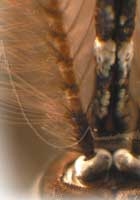The research was published in the Proceedings of the National Academy of Sciences. Professor Daniel Robert, senior author on the paper, said: “To our surprise, we found that the mosquito ear mechanically responds to enlarge its own range of detection. It makes the female appear closer than she actually is, giving the male a split second longer in which to react.” This behaviour enhances the male’s chance to capture and mate with a passing female. It may also be why such small animals have, comparatively speaking, such large ears.
Males detect female mosquitoes from the sounds generated by their wing-beat. As female wings are poor acoustic radiators – they don’t make much noise – males have been driven, by sexual selection, to evolve highly sensitive acoustic sensors. In addition, female sounds appear and vanish very suddenly, leaving the male with just a split second in which to detect her. A reflection of the demands of this task may be the fact that the ears of male mosquitoes contain up to 16,000 sensory cells, a number comparable to that contained in the human ear.
www.bio.bris.ac.uk
